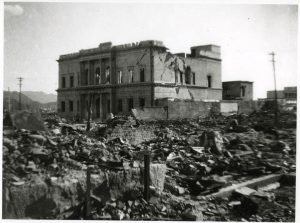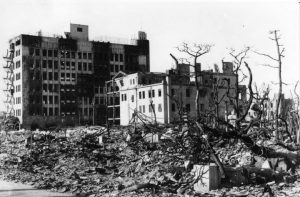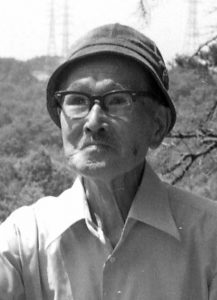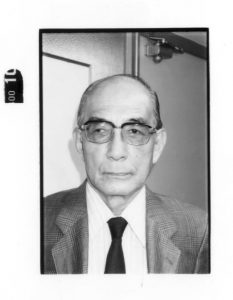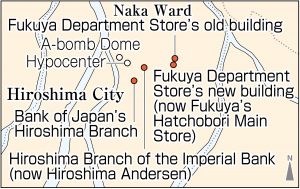Striving to fill voids in Hiroshima, evidence of victims remains 76 years after atomic bombing—Photos of A-bombing destruction, Part 8: Destroyed office and retail shop captured by Naomichi Inoue, Kazuma Hayashi
Dec. 12, 2021
Coworkers fell victim to atomic bombing: “I couldn’t stop trembling”
A-bombed buildings convey catastrophe
by Kyosuke Mizukawa, Staff Writer
The exterior west-side wall of the building, nearest the hypocenter, had crumbled and the roof on that side had caved in. Seventy-six years ago, the two-story ferroconcrete structure, with its Renaissance architectural style, was the Hiroshima Branch of the Imperial Bank, located on the Hondori shopping street (now part of Hiroshima's Naka Ward). Naomichi Inoue, then 32, who worked for the bank’s Hiroshima Branch and died at the age of 92 in 2005, took photographs of the building between the end of August and the beginning of September 1945.
Stayed home at time of atomic bombing
In an article carried in the Chugoku Shimbun on August 30, 1994, Mr. Inoue spoke about how he “couldn’t stop trembling.” Before his death, Mr. Inoue talked to the Chugoku Shimbun about the shock he felt at the time he snapped the photos. The building was located 360 meters from the hypocenter. He also aimed his camera at the inside of the branch office, strewn with rubble but without traces of desks or counters.
Mr. Inoue, a loan teller at the branch office, was drafted in June 1945 into the military and assigned to an infantry corps based on the east side of Hiroshima Castle. At the beginning of August, he was ordered to isolate himself from the rest of the unit with a suspected infection. On the morning of August 6, he experienced the atomic bombing at his home, located about 1.7 kilometers north of the hypocenter.
Although he suffered burns on his head and arms, in an interview with the Chugoku Shimbun, Mr. Inoue said that he had been lucky just to survive. His older brother-in-law, also an employee at the branch office, experienced the atomic bombing on his way to the office. His remains were never found. The Record of the Hiroshima A-bomb War Disaster, published in 1971, describes that those who had escaped instant death in the office building eventually died, with 32 employees of the branch office falling victim to the atomic bombing.
Two days after the bombing, banks in Hiroshima City that sustained major damage, including the Imperial Bank, began temporary operations in the Bank of Japan's Hiroshima Branch building, which had survived the fires that arose in the aftermath of the bombing. According to the account of the late Tsuneichi Okitsu, an employee of the Imperial Bank’s Hiroshima Branch who survived the bombing at his home, a U.S.-manufactured safety deposit box in the branch office survived the bombing, but the deputy manager in possession of the safe’s key was missing. Within about one month, the Imperial Bank had received a loan from the Bank of Japan and refunded the deposits of its customers.
Mr. Inoue began to work at the Bank of Japan office at the end of August after undergoing medical treatment for his injuries suffered in the bombing. In response to the request that he report the extent of the branch office damages to the head office, he took photos of the branch office with a camera he had left at an acquaintance’s home. When the damaged office building was repaired in 1950, it was reported that he “negotiated with the headquarters of the British Commonwealth Occupation Forces, based in Kure City in Hiroshima Prefecture, and obtained a special distribution of cement.” Afterward, because he was transferred to Tokyo, Mr. Inoue departed from Hiroshima.
In 1967, the Andersen Group, a group of European-style bakeries headquartered in Hiroshima, purchased the building and opened a shop at which it baked and sold bread. In August 2020, a new store opened after the building was reconstructed with part of an A-bombed wall from the original structure. A plaque showing a photo taken by Mr. Inoue is situated in the front part of the store.
Building used to exhibit history
In and around the Hatchobori area near the Hondori shopping street, the new building of the Fukuya Department Store (now Fukuya’s Hatchobori Main Store) and its old building, standing across from the new building, were among those exposed to the atomic bombing 700 meters from the hypocenter. Neither building collapsed, but each of their interiors was incinerated.
Kazuma Hayashi, an employee of the Fukuya Department Store who died at the age of 84 in 1979, aimed his camera at the store after the atomic bombing. He was 50 years old at the time. According to the Record of the Hiroshima A-bomb War Disaster and other sources, he was chief of the product administration section at the Fukuya Department Store but then worked for a distribution company located in the area of Minamikanon-machi (now part of Nishi Ward) as a worker on loan. After he experienced the atomic bombing in the dormitory of the distribution company, he took refuge in present-day Higashihiroshima City, where his family had been evacuated. In the fall of 1945, he commuted to Hiroshima City for other work and took photos of the burned ruins of the Fukuya Department Store and its surroundings.
Engaged in the establishment of the Hiroshima Alpine Club before World War II, Mr. Hayashi is said to have owned a camera that he used when mountain climbing. In the Record of the Hiroshima A-bomb War Disaster, Mr. Hayashi was quoted as saying, “I began to snap the shutter of my camera, once used for my travels to mountains, with a focus on the city of rubble.”
The Fukuya Department Store in Hatchobori continues operations today while retaining its status as an A-bombed building. In 2019, the 90th anniversary of its foundation, the department store created an exhibit space to communicate the histories of the store and Hiroshima at which about 110 photos are exhibited. Two photos taken by Mr. Hayashi are displayed in the space. The photos, taken and left by former employees, clearly communicate to the present era the catastrophe caused by the atomic bombing and the starting point for reconstruction.
(Originally published on December 12, 2021)

